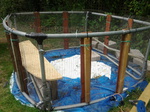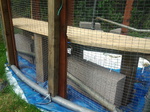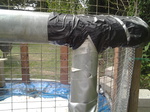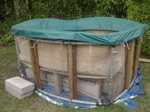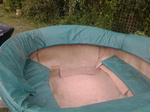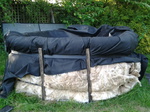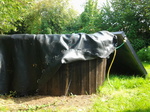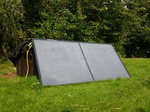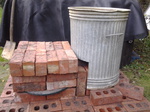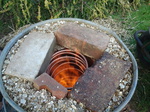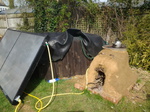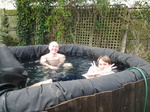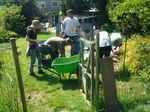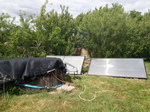
Recycled 'Trampoline' Solar Hot Tub!
We don't go away on expensive holidays, mainly because we don't fly for environmental reasons, so this project was to give us a bit of luxury. We reconditioned a solar thermal flat panel (from our own system when it was replaced, deemed broken but only actually blocked) These are basically a coiled pipe in a black perspex fronted box so you could make a similar panel from an old hosepipe painted black . The materials for this hot tub were:-
- an old trampoline, including framework, surround padding and nylon mesh
- old aviary wire
- some spare chipboard sheets left over from garage flat roof
- old carpet
- old kids paddling pool
- old fence posts, fence slats, batons
- reconditioned solar thermal flat panel
- some new concrete blocks
- new insulation made from recycled plastic bottles
- new duck tape
- new cable ties
- new pond liner
- two new lorry cables
- new pond pump and UV filter
Total cost of new parts approx £250
The framework of the trampoline was rejigged to make two circles(ish) with supporting struts at the corners. These were cable tied and duck taped together. Concrete blocks and chipboard were used to make the seats and provide support for the aviary wire against the weight of the water. Fence batons and slats also provide support when the lorry ties are tightened around the framework. The whole thing is insulated with unrottable recycled plastic-bottle roof insulation and the inner layer of carpet, which also protects the liner from the wire and the exterior is protected with old fence slats that are cable tied together.The padding from the trampoline adds comfort when climbing in and resting your head and gives extra protection for the pondliner. We have used a fairly expensive liner costing approx £120. The whole thing is covered when not in use with the trampolne bouncy mesh - which allows rainwater to collect and be pumped up to the rainwater storage tanks for use in the polytunnel, but stops algae growing and keeps leaves and bits out. When in use and we want to keep the heat in overnight we put a 'duvet' of insulation on top of the mesh, insulation securely wrapped in double layered bin bags.
The solar heating system works with a pond pump and filter pumping water through the solar panel leaning against the south facing edge of the tub. The UV filter cleans the water but we will not keep the water in use for more than a few days at a time once we have started using it - during those occasional sunny heat waves we get (well we did this year) for hygiene reasons as we do not want to add chemicals. This is a large hot tub and it takes 2 or 3 days to get to a good summer 'warm' tub - just lovely to float in during summer evenings with a glass of cider on the side. Our next plan is to build a rocket stove wood burning system to heat it in cooler summers or even during winter time.
Once used, the water is not wasted - but pumped up to the duck pond, or through the polytunnel watering system.
Rocket Stove update - in 2015 we've added a home built cob and dustbin rocket stove to provide additional heating to the hot tub. the pictures above show the basics of the rocket stove, which we tested before covering with cob from the garden again. The fuel is all the top 'sticky' bits of our hedgerow prunings made into faggots. A rocket stove operates by creating a really fast burn, that burns the wood gases and produces no smoke and little pollution. The copper coil inside the chimney has water pumped through it ( don't burn without the water as you will melt the copper) via the solar panel first and then the stove, just for those days when you need some extra heating.
2018 - Hot tub relocated and Solar Shower added- in 2018 we moved the whole hot tub down to the new camping area, and created a solar shower next to the solar panels so that it could double for the shower system. We had been given another identical panel so this was added in line . An old climbing frame became a changing cubicle with hessian curtains for modesty, with a second hand water cistern raised on a platform above it. Mains pressure moves water through the panels and up to the cistern. When run for 5 to 10 minutes you then have enough hot water for 1 to 3 short showers. On less sunny days we can pump water around the whole system (an electric pump can be run off our solar pV panels even on semi bright days) for an hour to generate enough hot water. The water runs from the cistern to a garden rose hanging in the willow shower cubicle, which has a plastic grid with a rubber matting cover to keep feet clean. The willow loves the greywater!
